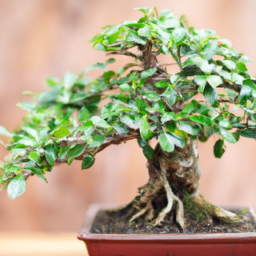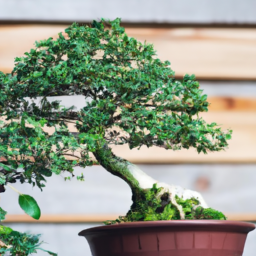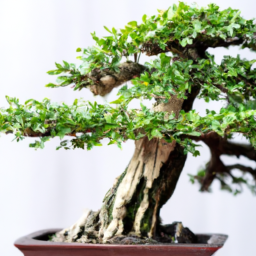
Are you looking to bring a touch of nature into your home or office? Indoor types of bonsai trees are the perfect solution! These miniature trees are not only beautiful to look at, but they also provide a sense of tranquility and peace. Whether you are a seasoned bonsai enthusiast or a beginner looking to start your own collection, indoor bonsai trees are a great option for adding a touch of greenery to your indoor space. In this blog post, we will explore some of the best indoor bonsai tree varieties, care tips, and how to incorporate these small wonders into your home decor. Let’s dive in and discover the beauty of indoor bonsai trees together!
Popular Indoor Bonsai Tree Varieties
Ficus Bonsai
When it comes to indoor bonsai trees, one of the most popular varieties is the Ficus Bonsai. Ficus trees are known for their glossy leaves and their ability to thrive indoors. They are relatively easy to care for and can adapt well to different light conditions. To keep your Ficus Bonsai healthy, make sure to place it in a bright spot with indirect sunlight. Water your Ficus Bonsai when the top inch of soil feels dry to the touch, and make sure to mist the leaves regularly to maintain humidity.
Another important aspect of caring for your Ficus Bonsai is pruning. Regular pruning will help maintain the shape and size of your tree, as well as promote new growth. You can also wire your Ficus Bonsai to guide its growth and create interesting shapes. Overall, the Ficus Bonsai is a great choice for beginners and experienced bonsai enthusiasts alike.
Jade Bonsai
Jade Bonsai trees are another popular choice for indoor bonsai enthusiasts. These trees are known for their thick, fleshy leaves and their resilience to neglect. Jade Bonsai trees are easy to care for and can thrive in a variety of light conditions. To keep your Jade Bonsai healthy, make sure to place it in a spot with bright, indirect sunlight. Water your Jade Bonsai sparingly, allowing the soil to dry out between waterings.
Pruning is also important for maintaining the shape and health of your Jade Bonsai tree. Regular pruning will help prevent overcrowding and encourage new growth. You can also wire your Jade Bonsai to create interesting shapes and styles. With proper care and attention, your Jade Bonsai tree can live for many years and bring beauty to your indoor space.
Chinese Elm Bonsai
Chinese Elm Bonsai trees are a popular choice for indoor bonsai enthusiasts due to their elegant, twisting trunks and small, glossy leaves. These trees are relatively easy to care for and can adapt well to indoor environments. To keep your Chinese Elm Bonsai healthy, place it in a spot with bright, indirect sunlight. Water your Chinese Elm Bonsai when the top inch of soil feels dry to the touch, and make sure to mist the leaves regularly to maintain humidity.
Pruning is essential for maintaining the shape and size of your Chinese Elm Bonsai tree. Regular pruning will help promote new growth and prevent overcrowding. You can also wire your Chinese Elm Bonsai to create interesting shapes and styles. With proper care and attention, your Chinese Elm Bonsai tree can thrive indoors and bring a sense of tranquility to your space.

Tips for Caring for Indoor Bonsai Trees
Choosing the Right Indoor Bonsai Tree
When it comes to choosing the right indoor bonsai tree, there are a few factors to consider. First and foremost, you’ll want to think about the amount of light your bonsai tree will receive. Some indoor bonsai trees, like the Ficus or Jade, prefer bright, indirect light, while others, like the Chinese Elm or Fukien Tea, can tolerate lower light conditions.
Another important factor to consider is the humidity levels in your home. Some indoor bonsai trees, such as the Serissa or Azalea, prefer higher humidity levels, while others, like the Juniper or Pine, can tolerate drier conditions. It’s important to research the specific needs of the bonsai tree you choose to ensure it thrives in your home environment.
Lastly, consider the size of the bonsai tree. Some indoor bonsai trees, like the Dwarf Jade or Shohin Elm, are perfect for small spaces, while others, like the Ficus or Chinese Elm, can grow quite large. Make sure you choose a bonsai tree that fits the space you have available and that you’re comfortable caring for.
Providing the Right Care for Your Indoor Bonsai Tree
Once you’ve chosen the right indoor bonsai tree for your home, it’s important to provide the proper care to ensure its health and longevity. Here are some tips for caring for your indoor bonsai tree:
1. Watering: Proper watering is crucial for the health of your indoor bonsai tree. Most indoor bonsai trees prefer to be watered when the top layer of soil feels dry to the touch. Make sure to water thoroughly, allowing excess water to drain out of the bottom of the pot to prevent root rot.
2. Light: Indoor bonsai trees require adequate light to thrive. Place your bonsai tree near a window that receives bright, indirect light for most of the day. If your home doesn’t receive enough natural light, consider supplementing with a grow light to ensure your bonsai tree gets the light it needs.
3. Humidity: Some indoor bonsai trees, like the Serissa or Azalea, prefer higher humidity levels. To increase humidity around your bonsai tree, consider placing a humidity tray filled with water and pebbles near the tree or misting the leaves regularly.
4. Fertilizing: Indoor bonsai trees benefit from regular fertilization during the growing season. Use a balanced liquid fertilizer diluted to half strength every two weeks to provide your bonsai tree with the nutrients it needs to thrive.
5. Pruning and Training: Regular pruning and training are essential for maintaining the shape and health of your indoor bonsai tree. Use sharp bonsai shears to trim back new growth and shape your tree as desired. Additionally, consider wiring branches to achieve the desired shape and form.
Troubleshooting Common Issues with Indoor Bonsai Trees
Despite your best efforts, you may encounter some common issues while caring for your indoor bonsai tree. Here are a few tips for troubleshooting these issues:
1. Yellowing Leaves: Yellowing leaves can be a sign of overwatering, underwatering, or nutrient deficiencies. Check the soil moisture level, adjust your watering schedule if necessary, and consider fertilizing your bonsai tree to address any nutrient deficiencies.
2. Pests: Indoor bonsai trees are susceptible to pests like aphids, spider mites, and scale insects. If you notice pests on your bonsai tree, gently wash the leaves with a mild soap solution and treat with neem oil or insecticidal soap to eliminate the infestation.
3. Root Rot: Root rot can occur if your indoor bonsai tree is overwatered or if the soil doesn’t drain properly. If you suspect root rot, gently remove the tree from its pot, trim away any rotting roots, and repot in fresh, well-draining soil.
By following these tips for caring for your indoor bonsai tree and troubleshooting common issues, you can ensure that your bonsai tree thrives in your home environment for years to come. Remember to research the specific needs of your bonsai tree and provide the proper care to promote its health and longevity.

Best Practices for Growing Indoor Bonsai Trees
As an expert in indoor bonsai trees, I have gathered valuable insights and tips to help you successfully grow and care for these beautiful miniature trees in your home. Indoor bonsai trees require special attention and care to thrive, but with the right practices, you can enjoy the beauty of these unique plants for years to come.
Choosing the Right Indoor Bonsai Tree
When selecting an indoor bonsai tree, it is important to consider the specific growing conditions in your home. Different species of bonsai trees have different requirements for light, humidity, and temperature. Some popular indoor bonsai tree species include Ficus, Jade, and Chinese Elm.
Before purchasing a bonsai tree, research the specific care requirements for that species to ensure it will thrive in your home environment. Consider factors such as the amount of natural light available, humidity levels, and the average room temperature.
It is also important to choose a bonsai tree that matches your skill level as a gardener. Some species of bonsai trees are more forgiving of mistakes and are easier to care for, making them ideal for beginners. Others require more advanced care and attention, so it is important to choose a tree that aligns with your experience level.
Creating the Ideal Growing Environment
Once you have selected the right indoor bonsai tree for your home, it is important to create an ideal growing environment to promote healthy growth and development. Indoor bonsai trees require adequate light, humidity, and temperature to thrive.
Place your bonsai tree in a location that receives plenty of natural light, such as a south-facing window. If natural light is limited, consider supplementing with a grow light to ensure your bonsai tree receives the light it needs to grow and thrive.
Indoor bonsai trees also require high humidity levels to prevent the leaves from drying out and to promote healthy growth. To increase humidity around your bonsai tree, place a humidity tray filled with water and pebbles near the tree or use a room humidifier.
Proper Care and Maintenance
Regular care and maintenance are essential for the health and longevity of your indoor bonsai tree. Watering, pruning, fertilizing, and repotting are all important tasks that will help your bonsai tree thrive and grow beautifully.
Water your bonsai tree regularly, but be careful not to overwater as this can lead to root rot. Allow the soil to dry out slightly between waterings and adjust your watering schedule based on the season and the specific needs of your bonsai tree species.
Pruning is another important aspect of bonsai tree care, as it helps shape the tree and promote healthy growth. Regularly prune back new growth and remove any dead or damaged branches to maintain the tree’s shape and overall health.
Here are the Essential Points
Are you looking to bring a touch of nature into your home? Indoor bonsai trees could be the perfect addition to your living space! These miniature trees are not only beautiful to look at but also provide a sense of tranquility and calmness to any room.
There are many different types of indoor bonsai trees to choose from, each with its own unique characteristics and care requirements. Some popular options include the Ficus, Jade, and Chinese Elm bonsai trees. Whether you’re a seasoned bonsai enthusiast or a beginner looking to dip your toes into the world of bonsai, there is a perfect indoor tree out there waiting for you. So why not bring a little piece of nature indoors and enjoy the beauty of these miniature trees in your own home?
Your Burning Questions Answered:
Q1. What are some popular types of indoor bonsai trees?
A1. Some popular types of indoor bonsai trees include Ficus, Jade, Chinese Elm, and Fukien Tea.
Q2. How do I care for indoor bonsai trees?
A2. Indoor bonsai trees require regular watering, proper lighting, and occasional pruning to maintain their health and shape.
Q3. Can indoor bonsai trees be placed outdoors?
A3. While indoor bonsai trees can tolerate some outdoor conditions, they are best kept indoors to protect them from extreme temperatures and weather.
Q4. How often should I fertilize my indoor bonsai tree?
A4. Indoor bonsai trees should be fertilized every 4-6 weeks during the growing season with a balanced liquid fertilizer.
Q5. Are indoor bonsai trees suitable for beginners?
A5. Yes, indoor bonsai trees can be suitable for beginners as long as they are willing to learn about proper care and maintenance techniques. Start with easy-to-care-for varieties like Ficus or Jade to build your confidence as a bonsai gardener.
Dr. Olivia Green is a botanist with over two decades of experience in indoor plant cultivation. She holds a Ph.D. in Plant Biology and has dedicated her career to researching plant behavior in controlled environments. Dr. Green is passionate about helping plant enthusiasts master the art of indoor gardening through her extensive knowledge and practical insights.


